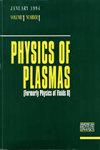研究在阴极表面微突起附近的亚纳秒高压和超高压气体放电中产生失控电子的可能性
IF 2.2
3区 物理与天体物理
Q3 PHYSICS, FLUIDS & PLASMAS
引用次数: 0
摘要
在 1-40 atm 的压力范围内,对氮气中自持续亚纳秒放电初始阶段的启动和发展动态过程进行了实验和理论研究,该放电是在有失控电子参与的均匀电场中发展的。获得了放电发展的预破坏阶段放电间隙中电场强度可达到的最大值数据,以及不锈钢阴极在亚纳秒高压脉冲训练期间形成的表面微凹凸照片。在这些数据的基础上,对阴极微不均匀附近一小块电场增强区域内由场致发射电子引发的电子雪崩的发展过程进行了三维数值建模。研究了电子在这些雪崩中过渡到失控状态的可能性。锥形微突起、金属滴以及孔隙和微凹坑之间的边界被视为微均质。研究表明,电子在微均质点附近获得的初始能量会极大地促进其进入失控状态。这种效应在气体压力高于 10 atm 时尤为明显。因此,在自持亚纳秒放电形成阶段,电子的失控模式可以在放电间隙中的平均减弱电场强度下实现,而该强度明显低于失控标准的要求。本文章由计算机程序翻译,如有差异,请以英文原文为准。
Investigation of the possibility of generation of runaway electrons in subnanosecond gas discharges of high and ultrahigh pressure in the vicinity of microprotrusions on the cathode surface
In the pressure range of 1–40 atm, experimental and theoretical studies of the processes of initiation and development dynamics of the initial stage of the self-sustained subnanosecond discharge in nitrogen, developing in a uniform electric field with the participation of runaway electrons, were carried out. Data on the maximum achievable values of the electric field strength in the discharge gap at the pre-breakdown stage of the discharge development and photographs of the microrelief of the surface of a stainless steel cathode formed during its training by subnanosecond high-voltage pulses were obtained. These data served as the basis for numerical 3D modeling of the development of an electron avalanche initiated by a field emission electron in a small region of enhanced electric field near a microinhomogeneity on the cathode. The possibility of transition of electrons in these avalanches to the runaway regime was studied. Cone-shaped microprotrusions, metal drops, and boundaries between pores and microcraters were considered as microinhomogeneities. It has been shown that the initial energy obtained by an electron near the microinhomogeneity can significantly facilitate its transfer into the runaway regime. This effect is especially noticeable at gas pressures higher 10 atm. As a result, at the stage of a self-sustained subnanosecond discharge formation, the runaway mode of an electron can be realized at the average reduced electric field strengths in the discharge gap, which are significantly lower than required by the runaway criterion.
求助全文
通过发布文献求助,成功后即可免费获取论文全文。
去求助
来源期刊

Physics of Plasmas
物理-物理:流体与等离子体
CiteScore
4.10
自引率
22.70%
发文量
653
审稿时长
2.5 months
期刊介绍:
Physics of Plasmas (PoP), published by AIP Publishing in cooperation with the APS Division of Plasma Physics, is committed to the publication of original research in all areas of experimental and theoretical plasma physics. PoP publishes comprehensive and in-depth review manuscripts covering important areas of study and Special Topics highlighting new and cutting-edge developments in plasma physics. Every year a special issue publishes the invited and review papers from the most recent meeting of the APS Division of Plasma Physics. PoP covers a broad range of important research in this dynamic field, including:
-Basic plasma phenomena, waves, instabilities
-Nonlinear phenomena, turbulence, transport
-Magnetically confined plasmas, heating, confinement
-Inertially confined plasmas, high-energy density plasma science, warm dense matter
-Ionospheric, solar-system, and astrophysical plasmas
-Lasers, particle beams, accelerators, radiation generation
-Radiation emission, absorption, and transport
-Low-temperature plasmas, plasma applications, plasma sources, sheaths
-Dusty plasmas
 求助内容:
求助内容: 应助结果提醒方式:
应助结果提醒方式:


